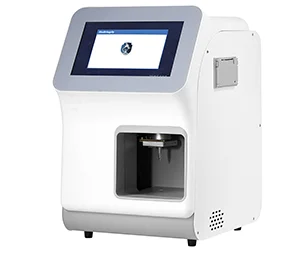Freezing Point Osmometers: Your Tool for Quick, Accurate Osmolality Testing
Freezing Point Osmometers: Your Tool for Quick, Accurate Osmolality Testing

Understanding how materials act in different situations is key to science and business. One interesting effect, freezing point depression, matters a lot in fields like chemistry, biology, and industry. This idea powers a freezing point osmometer—a smart device used to measure the concentration of solutions. In this article, we’ll look at the idea behind freezing point depression, how it helps measure osmolality, and why freezing point osmometers are useful in many areas.
Principles of Freezing Point Depression
Freezing point depression isn’t just a lab trick. It’s a basic property that impacts real-world uses, from medical tests to food safety.
Scientific Basis of Freezing Point Depression
Freezing point depression happens when you mix a substance into a liquid, making it freeze at a lower temperature. The added particles mess up the liquid’s ability to form solid crystals. So, it needs a colder temperature to turn solid. The amount the freezing point drops depends on how many particles are added, not what kind they are.
Relationship Between Solute Concentration and Freezing Point
The link between the amount of substance and the freezing point is simple. More substance means a lower freezing point. This connection lets us figure out osmolality, which is a way to measure how many particles are in a certain amount of liquid, by checking how much the freezing point changes.
Application of the Theory in Osmolality Measurement
Freezing point depression is the science behind measuring osmolality with tools like freezing point osmometers. Osmolality shows the total number of dissolved particles. It’s a key factor in medical tests, drug making, and quality checks.
What Is a Freezing Point Osmometer?

To put this science to work, freezing point osmometers are used in many fields to measure solution strength with great accuracy.
Definition and Core Functions
A freezing point osmometer is a device that measures osmolality by checking a liquid’s freezing point. It cools a sample until it starts to form crystals, then records the steady temperature. The Freezing Point Osmometer is one of MedIntegrity’s main products for drug and lab work.
Key Components and Operating Mechanism
A freezing point osmometer usually has a cooling area, a temperature sensor (like a thermistor or thermocouple), a sample holder, and a screen to show results. First, the sample is cooled below its freezing point. Then, it’s stirred to start crystal formation. The temperature rises a bit and settles at a steady point. This point is the solution’s true freezing point.
Types of Samples Measured
Freezing point osmometers can handle many kinds of liquids. These include body fluids (like blood, plasma, or urine), drugs (like injections or IV fluids), food items (like juices or milk), and even industrial liquids like coolants or antifreeze.
Advantages of Using Freezing Point Osmometers
Using freezing point osmometers comes with several big benefits. They’re essential in both research labs and workplaces.
- Speed and Ease in Testing: These devices give quick results with little setup. A test can finish in just a few minutes. This speed helps in busy places like hospitals or during large-scale drug production.
- High Accuracy and Reliability: Modern freezing point osmometers use advanced cooling systems and sensitive sensors. They provide very exact measurements, often within ±1 mOsm/kg H₂O, and give consistent results every time.
- Works with Many Sample Types: These tools can test different liquids without losing accuracy. They’re great for checking blood in hospitals or testing drug solutions during production.
Applications Across Industries
Freezing point osmometers aren’t just for school labs. They’re vital in healthcare, drug making, food production, and more.
Clinical Diagnostics and Medical Laboratories
In hospitals, these devices test body fluids like blood or urine. Osmolality tests help doctors spot issues like low sodium levels or dehydration. These tests are crucial for patients in intensive care, where managing fluids can save lives.
Pharmaceutical Quality Control
Drug companies need exact osmolality measurements to ensure their products are safe and work well. Testing makes sure injectable drugs match the body’s natural balance. This is key for patient safety and meeting government rules.
Food and Beverage Industry
In food labs, osmometers check product quality. They measure sugar in drinks or salt in processed foods. Keeping osmolality steady ensures consistent taste. It also helps spot risks of germ growth.
Technical Considerations When Choosing a Freezing Point Osmometer
Picking the right osmometer means looking at features that fit your needs.
- Sensitivity and Measurement Range: Choose a model that matches your samples. Body fluids usually need a range of 0–2000 mOsm/kg. Industrial liquids might need a range up to 3000 mOsm/kg or higher.
- Sample Size Needs: Some models only need 20 µL of liquid. This is great for rare or costly samples, like spinal fluid or special drug mixes.
- Calibration and Upkeep: Many devices come ready to use but should allow calibration with standard solutions. This keeps them accurate over time with little downtime.
Innovations in Modern Freezing Point Osmometers
New technology has made these devices better and easier to use.
- Connection to Digital Systems: Many osmometers now have USB ports or Wi-Fi. They can link to lab data systems, making it easier to track results for audits.
- Automatic Sample Handling: Automation cuts down on mistakes. Some devices have robotic arms or trays for testing many samples at once, saving time.
- Meets Regulatory Standards (FDA, GMP, USP, EP): The testing methods comply with the requirements of the FDA, GMP, USP, and EP. This makes them reliable for use in regulated settings.
MedIntegrity: A Trusted Supplier of Freezing Point Osmometers
For groups looking for reliable tools and great support:
Company Profile and Industry Experience
ความเป็นปอด, based in the U.S.A., specializes in precise testing tools and supplies for drug companies. We’ve built a strong name by focusing on high-quality devices for regulated industries.
Commitment to Innovation and Quality
We’re more than just a tool provider. We offer solutions to improve testing processes, backed by our deep knowledge.
Product Offerings Tailored to Pharmaceutical Needs
Our Freezing Point Osmometer is a top product, designed for drug quality control where accuracy is critical.
Customer Support and After-Sales Services
If any issues arise during the warranty period, we offer free repairs. Our support includes help with maintenance and calibration, ensuring devices work well for years.
Summary of Key Benefits
Freezing point osmometers give accurate results based on solid science. They’re fast, work with many liquids, and follow strict rules. With support from trusted companies like MedIntegrity, they’re essential for medical tests, drug production, and food safety programs.
FAQs
Q1: How accurate are freezing point osmometers compared to other methods?
A: Freezing point osmometers are very accurate for measuring osmolality. They usually have precision within ±1 mOsm/kg H₂O, depending on the model.
Q2: Can I use one osmometer for both medical and industrial liquids?
A: Yes. Many models have wide ranges that work for low-concentration body fluids (like blood) and high-concentration industrial liquids (like antifreeze).
Q3: Are MedIntegrity’s instruments compliant with global pharmaceutical regulations?
A: Yes. Our devices fully comply with the requirements of the FDA, GMP, USP, and EP. They’re suitable for use in regulated drug production worldwide.







